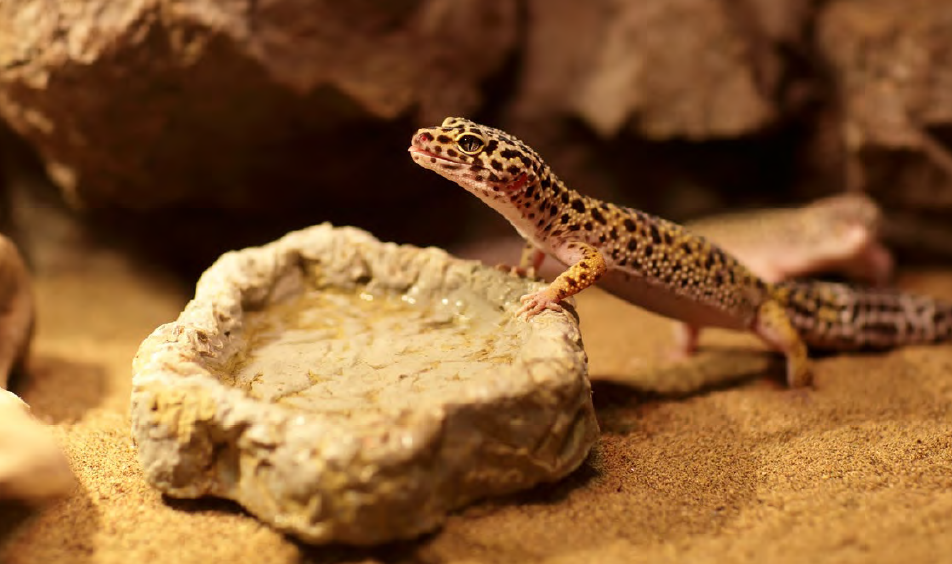Replicating Natural Habitats
John Mack //October 25, 2017//
When examining what goes into a cage or enclosure, a major aspect is the substrate and caging material that comes with keeping a reptile.
Substrate, as a general term, refers to the surface upon which a given organism lives. For our context, this refers to a material placed in the bottom of an enclosure, serving as a combination of flooring and bedding for your reptiles. There are a number of various forms of substrate available to consumers, ranging from sand and gravel, to processed wood and paper products, to soil and moss, to artificial surfaces including artificial grasses and even linoleum and tile.
As with caging, much of your—and your customers’—choices in substrate will rely upon the type of reptile chosen. Playground sand, for example, is a poor choice for most snakes, as the fine grains can be accidentally ingested or clog various bodily openings. Similarly, gravel is rarely a good choice for species that require high humidity, as the stones will not hold moisture. However, stone may make a phenomenal choice for species that require a good deal of dry heat, mimicking their natural environment.
In all cases, special care and attention must be paid to a given reptile’s natural habitat, and your first instinct should always be to replicate that environment’s climate as best as possible. Many reptile owners—and even some breeders—often try to get away with the cheapest available option in this regard, sometimes relying on old newspaper, cedar shavings or even cat litter, but doing so can definitely harm that reptile’s longterm health. Particularly, substrates like playground sand, mulch from hardware stores or even newspaper can contain toxins, fertilizers or other chemicals that can be harmful to a reptile’s skin, digestive system or respiratory system. Walnut shell litter is particularly of note as harmful, as it is not only sharp to the point of being able to pierce more thin-skinned reptiles, but also provides a breeding ground for bacteria and fungi, leading to a higher chance of infection. To be sure, quality substrate is well worth the investment.
On the forefront of substrate technology stands Brian Barczyk, owner of BHB Reptiles in Michigan. In addition to breeding and selling reptiles, Barczyk manages his own YouTube channel, AnimalBytesTV, which serves more than 630,000 subscribers, with a legion of videos ranging from animal handling tips and species analyses to superlatives featuring massive snakes, spiders, and other unique animals.
Recently, Barczyk has branched out into substrate production via a brand known as Reptile Prime. He describes this new product, made from dust-free Coco fiber, as “a blend perfect for snakes, lizards, arachnids, and tortoises, which require a slightly higher humidity.”
He has his reasons for his choice of fiber over a more-prevalent moss.
“We feel that processing a bedding like coconut fiber to take the dust away really improves absorbency as well as ease of use,” Barczyk said. “With our patented process of separating out the three layers of a coconut shell, we can offer a bedding that is more suited to the specific needs of your reptile. Historically, the process would be to grind up all three parts into whatever size desired, but this leaves dust and other unwanted parts for your reptile. By separating the three parts out, we increase the absorbency by close to twice the industry standard, which means it holds humidity for much longer as well as removes the dust which is the ‘dirty’ part of coconut fiber.
“We are also working on a few other bedding products that will be an alternative to using sand as a bedding,” he continued. “Sand can hold bacteria and be abrasive to a reptile; we have a product on the horizon that will look similar and act similar but not have any sand in it whatsoever. We will continue to use technology to produce bedding products that will make keeping your pet reptile easier while keeping the health of your pet at the highest standard.”
Barczyk advocates that a reptile owner do a full change of substrate and bedding once per month to keep the reptiles happy and healthy. In doing so, he also recommends breaking the cage down fully and disinfecting the cage itself to prevent any outlying growth of bacteria or fungi.
“If we can provide bedding that reduces your work, it gives you more time to enjoy your pet and less time worrying,” he said.
As with so many of my articles, the key here is to communicate this knowledge to both your staff and
your customers. Your staff should be well-acquainted with the practice of changing out reptile bedding
and substrate, and this procedure should be performed on a regular schedule. By no means should anyone on your staff ever simply put a new reptile into a recently-vacated cage without thoroughly cleaning and sanitizing that cage first. Similarly, your customers must be made well aware of the necessity of proper clean substrate, as well as the procedures necessary to clean out their new pet’s home. Education is paramount. Substrates may not be the most exciting or enthralling topic for many
reptile owners, but they remain a critical element of any reptile owner’s equipment. And with new innovations like Barczyk’s Reptile Prime on the horizon, it becomes easier than ever to keep our scaly friends happy and healthful.



















